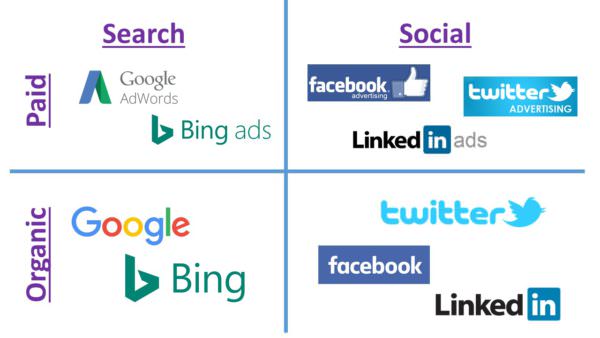There are various versions of the marketing funnel based on how you choose to map out your customer journey. For PPC purposes, we tend to look at it in 4 stages: awareness, consideration, decision, and retention.
You can see in the graphic above how our various tactics fit into the PPC marketing funnel. What’s important to remember is that even though earlier stages may have lower ROI, they drive people into the later stages.
Let’s take a look at each stage and some examples of how the tactics fit into an overall paid customer acquisition strategy.
Awareness Stage
The awareness stage is where prospects who have never heard of your product or service start. Typically, they will familiarize themselves via word-of-mouth, but with display advertising through Google Display Network or one of the various social platforms, we can accelerate the process.
Non-brand paid search can also drive some awareness. One example of this is when somebody knows about the product or service you offer but is unfamiliar with your brand. They could, for example, search “paid media companies” and see an ad for Augurian.
Consideration Stage
After awareness is achieved, prospects will begin to consider their options. This is where paid search and paid social start to work their magic, moving the prospect further towards a purchase.
Somebody thinking about buying a car could search “Chevy vs. Toyota reviews” and be targeted with a paid ad from one of the two. They could also be scrolling Facebook after liking a page about cars and see an ad in their news feed. These are examples of how both tactics can help turn prospects into customers.
Decision Stage
The decision stage starts when somebody is ready to make a purchase. They may have seen prior ads and been convinced that one make of car was better than the other. At this point, they could search “Chevy Cruze For Sale”, a search you would definitely want to be showing ads for if you are a local Chevy dealership.
On the paid social side, if someone has visited your site before, you can show ads in their Facebook feed and appear when they are ready to buy. Since cost-per-click is generally lower, you would also have some leeway to target a wider audience in hopes of finding prospects who are ready to buy.
This stage is perhaps the most critical since this is where they convert from a prospect or lead to a customer.
Retention Stage
Since we’ve already spent so much to acquire the lead or customer, it only makes sense to continue marketing to them. In this stage, remarketing tactics will push leads to convert into customers, and customers to repurchasers.
Both paid search and paid social have great remarketing options for this stage. These tactics have a very low cost-per-click, resulting in strong ROI.
Paid Search or Paid Social?
The search versus social debate will likely depend on your company and where the prospects and current customers live.
If people frequently use search engines to find your products or services, paid search will likely make more sense unless there is very high competition. Platforms such as AdWords offer search and display in the same interface, meaning you can utilize remarketing in tandem with your brand and non-brand search campaigns.
If search volume is not high, or if the cost-per-click is not feasible for your desired acquisition cost – paid social will likely make more sense. Detailed targeting features on platforms like Facebook and LinkedIn can let you find prospects in the consideration or even decision stage, along with the awareness they will drive. Since many people spend hours every day on these platforms, paid social is great for keeping your brand top-of-mind. These platforms also let you build remarketing audiences to help retain current customers and continue pushing non-purchasers down the funnel. (LinkedIn just rolled out remarketing earlier this year)
Ideally, companies will have budget to test both paid search and paid social, and determine which drives the most qualified leads and customers at the lowest cost-per-acquisition.
Where To Start In The Funnel?
Many companies looking to get started in paid media often ask: “With a limited budget, which tactics should we start with?”
The answer will vary based on budget, firm maturity, and competition. For newer companies with small budgets and high competition, it’s a no-brainer to start at the end of the funnel as ROI will be important right away.
More mature companies might choose to take a more comprehensive strategy, adding in display advertising to drive demand and then pulling it in with brand search and remarketing.





